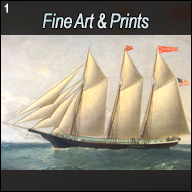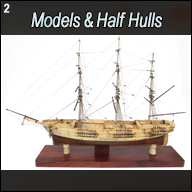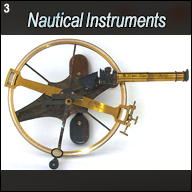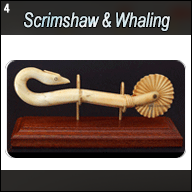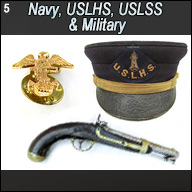2. Models & Half Hulls
Prices in U.S. Dollars are in GREEN
 |
2.87 MINI FLEET! Interesting selection of 6 near scale recognition models of World War era ships. This charming assembly consists of meticulously cast metal vessels ranging in size from 1 ¼ inches in length for the smallest, up to 2 ¾ inches for the two largest. In order of size they are: A mine sweeper with 2 distinctive gun mounts, mast, lifeboat, rafts and sweeping gear on the fantail. Next is a sleek silver corvette with 2 funnels, gun mounts and torpedo tubes. Third is the WWI German raider identified on the bottom as the MOEWE. It has multiple gun mounts. Fourth is an armed merchant illegibly identified on the bottom. It has a very tall mast and funnel, 2 lifeboats astride the deck house, a single gun aft and several cargo hatches. The fifth is a World War I submarine chaser identified as ‘‘RAVEN” with deck house, 2 funnels, 2 gun mounts and 2 depth charge racks. The sixth is the American destroyer escort identified as the EVARTES (DE-5) with prominent mast. All ships are in excellent condition and bear close scrutiny under magnification to reveal their astounding detail. SOLD |
 |
| detail |
 |
2.86 RECOGNITION MODEL. Authentic World War II U.S. Navy recognition model of the North Hampton class cruiser USS LOUISVILLE (CA-28). Early in the War such models were commissioned by the U.S. Navy to train gunners, spotters and pilots in the all important task of recognizing ships as friend or foe. To those ends the scale and detail of this model are truly incredible, down to individual gun barrels and midship cranes. Realistically, even the large gun turrets rotate! 6 inches long with a beam of 1/8 inch and 1 ¼ inches high. This all cast metal model is in excellent original condition with no damage or missing parts. Made by “A. PRAM & CO. Chicago 12-44” as embossed on the bottom. 95 LOUISVILLE was commissioned on January 15, 1931 and saw service in the Pacific and Caribbean up until the day of infamy on December 7, 1941 she was dispatched for the Pacific theatre where she actively participated until war’s end. On June 5, 1945 LOUISVILLE was attacked by a Japanese kamikaze killing 8 crewmen and wounding 45 others. For her dedicated service in World War II LOUISVILLE was awarded 13 battle stars. |
 |
 |
| above | reverse |
 |
 |
| name | kamikaze |
 |
| ship |
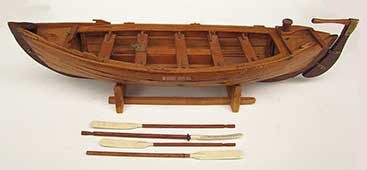 |
2.85/4.29 PLANK-ON-FRAME MODEL. Charming, sailor-made near scale model of an American whaleboat from the 19th century. This entirely scratch-built model is realistically molded using indigenous wood for frames and planking, and mahogany for the keel, cap rails and rudder. The rudder is realistically mounted using post and pintel attachments. Oarlock holders, cleat, tiller, logger head and chocks are similarly constructed. The model is complete with 4 very realistic oars. It also has a working brass hinge for attachment to a retractable sailing mast. The model is mounted in its original form-fitting hardwood stand. The model measures 12 ¼ inches from stem to back of the rudder. It has a beam of 3 ¼ inches and is 3 ¼ inches tall to the top of the tiller. Excellent original condition retaining its original varnished finish. 795 |
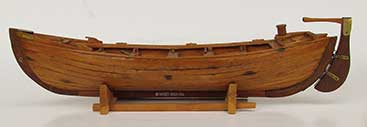 |
 |
| profile | interior |
 |
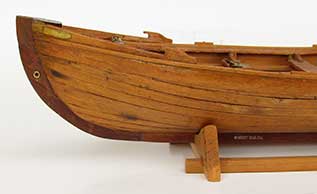 |
| hull | bow |
 |
| rudder |
 |
2.83 RECOGNITION MODEL. Genuine WWII miniature model of the famous World War II battlewagon the USS MASSACHUSETTS (BB-59). Early in the War such models were commissioned by the U.S. Navy to train gunners, spotters and pilots in the all important task of recognizing ships as friend or foe. To those ends the scale and detail of this model are truly incredible, down to individual gun barrels and even the spotter plane on the catapult of the fantail. 6 ¾ inches long with a beam of 1 ½ inches and 1 3/16 inches high. This all cast metal model is in excellent original condition with no damage or missing parts. 95 The USS MASSACHUSETTS (BB-59) was commissioned on May 9, 1942 and was dispatched to eastern front of the Atlantic where she participated in the Battle of Casablanca. In November she was assigned to the Pacific Fleet where she fought the Japanese in several famous engagements through War’s end. For her service she was awarded 11 battle stars. In January 1986 she was designated as a National Historic Place. She currently resides in Battleship Cove, Fall River, Massachusetts as a museum ship. |
 |
 |
| detail | bottom |
 |
| shiP |
 |
| IMAGES COMING SOON |
 |
 |
 |
| comparison | left |
 |
 |
| right | ship 1 |
 |
 |
| ship 2 | ship 3 |
 |
 |
| ship 4 | ship 5 |
 |
2.80 AMERICAN HALF HULL. Genuine late 19th century American ship builder’s half block model of a sailing ship. This authentic dockyard model is constructed in 10 alternating pine and mahogany lifts, mounted on its original backboard. Of great significance to its desirability is the fact that it is identified on the starboard stern quarter “UTILITY 1888.” Its graceful lines depict a working sailing vessel of the era, pinned and dowelled in successive layers for measurements used to construct the actual ship’s ribs in the molding loft. The vessel itself measures 36 ¾ inches in length from stem to stern by 5 ½ inches high. It has a breadth of 4 ¼ inches. The backboard measures 40 by 7 inches. Very sound original condition in its original finish. A very manageable, displayable size. This post-Civil War ship is well over 135 years old! SOLD “The List of Merchant Vessels of the United States 1889,” lists this ship on page 391. It is identified as the Unrigged Merchant Vessel “UTILITY,” Official Number 25110, built in Norwich, Connecticut in 1867 with a length of 506.8 feet and a gross tonnage of 566.8 tons. In 1889 it was homeported out of New York. |
 |
 |
| stern | bow |
 |
| back |
 |
2.73 FIRST U.S. NAVY REPAIR SHIP. Here is a true-to-life miniature model of the first American repair ship in the U.S. Navy, the USS MEDUSA (AR-1). This very rare scratch-built wood and metal model depicts the miniature ship in exquisite detail. The vessel is shown at anchor with the chain extending to the surface. Navy stockless anchors are depicted on either side of the bow. The foc'sle has a complicated raised platform mounted with a 100 mm gun flanked by 2 more guns of the same caliber and 2 funnels. The foremast is rigged with 5 van guy wires with 2 deck winches and 2 raised cargo hatches. The 03 navigation bridge is behind. On the 04 flying bridge is the enclosed navigating station with a searchlight aft. It is flanked by 2 lifeboats and the entire foredeck is ringed by delicate double life rails. On the main deck amidships are 2 derricks with various deck cargo. Large raised aft section has a small deckhouse just aft of the king post. 2 ladders with handrails lead into the superstructure. Above 4 lifeboats are on deck on both sides. The ship's smokestack has a steam whistle and 4 ventilators. Behind is another cargo hatch and the aftermast with 4 derricks and cargo winches. The mast is stepped with a "tops" platform and 2 support wires leading to the stern. Another searchlight is mounted between 2 deck lockers. The fantail has a large 2-deck house. The American ensign (made of painted metal) flies from the stern. Notably the entire aft section also has detailed double railing and the accommodation ladder with supporting davit is rigged on the port side. 7 ¼ inches long by 1 1/8 inches wide. An exquisite miniature model both in terms of execution and scale. 849 The USS MEDUSA (AR-1) was commissioned on September 18, 1924. She was the first ship in the U.S. Navy to be constructed solely for the purposes of being a deployable repair platform. MEDUSA saw action in the Pacific during World War II and was awarded one battle star. After her war service she was decommissioned in late 1946. |
This real museum model was actually exhibited at the prestigious De Young Museum in San Francisco from the early 1950's. It was entirely hand-made by an obviously very talented miniaturist using wood and metal components. There is no plastic. It comes from the collection which was acquired in 2006 when the museum began selling some major assets in order to fund its expansion program.
 |
 |
BOW DETAIL |
STERN DETAIL |
 |
 |
STARBOARD |
SHIP |
 |
2.74 FIRST U.S. NAVY HOSPITAL SHIP. The first hospital ship in the American Navy, USS RELIEF (AH-1). This incredible scratch built model ranks in the top three of the museum's collection of miniature models. The attention to detail exhibited by the professional model maker is obvious. A single Navy stockless anchor is on the port bow. Presumably the starboard anchor is down. At the peak the ship flies the Union Jack. The foc'sle has an anchor windlass, 4 ventilators and 3 covered access ladders to below decks. The foremast sports 3 cargo derricks with lines and 2 cargo hatches. It carries a crow's nest and a yardarm above. It is flanked by motor launches, port and starboard. The foc'sle is rimmed by fine double life lines. The raised foc'sle is above the short main deck with access provided by 2 railed ladders. These lead to accommodation ladders on either side of the ship. The conning bridge is on the 04 level with the flying bridge above. The main house is 2 decks with a narrower house above which supports the smokestack, 4 ventilators and skylights above the engineroom. Just abaft the navigation bridge is a smaller house holding 2 deck lockers and a telescope amidships. The 02 level carries 3 lifeboats in their davits on each side, for a total of 6. The aftermast with 4 van guy wires and yardarm is just aft of the house. It has 2 cargo derricks and a cargo handling winch. The derricks rest on the aftermost house which is located just between 2 more lifeboats in their davits. Behind it is another skylight and 2 deck lockers. All of the amidships house is encircled by very fine double life rails. On the fantail is another deck locker and a flagpole flying the American ensign. As configured the ship is shown at anchor. 7 inches long by 1 inch wide. Identified on the bottom as "USS RELIEF (AH-1)." Outstanding original condition. 849 USS RELIEF (AH-1) was commissioned on December 23, 1919 a little more than a month after the end of WWI. In that devastating war it had become obvious that a mobile hospital was essential to the United States' effective prosecution of war. Accordingly, the Second World War proved the ship's value to the American war effort. Serving in the Pacific theater, RELIEF garnered 5 battles stars for her service. Shortly after the war ended the old veteran was decommissioned on June 11, 1946. |
This real museum model was actually exhibited at the prestigious De Young Museum in San Francisco from the early 1950's. It was entirely hand-made by an obviously very talented miniaturist using wood and metal components. There is no plastic. It comes from the collection which was acquired in 2006 when the museum began selling some major assets in order to fund its expansion program.
 |
 |
| DETAIL | FORWARD DETAIL |
 |
| PORT |
 |
2.77 WEST COAST LUMBER SCHOONER. Perhaps our favorite in a nostalgic way, having been raise in the Pacific Northwest. This is a charming model of the plucky steam schooner S.S. OREGON. This model is the smallest of all in the collection. But in miniatures "small" is not necessarily detrimental. In fact the smaller the better! This little scale model has a raised foc'sle with anchor windlass. The foc'sle is encircled by fine life rails. 2 ladders with railing descend to the main deck. The deck exhibits the foremast with two derricks and supporting cables. 2 large hatch covers dominate the deck, followed by the aftermast with 2 more derricks and cables. The aft house has the smokestack behind which is the engineroom skylight. They are flanked by lifeboats on either side in their davits. The entire deck is encircle by fine life rails. 4 inches long by 7/8 inches wide. Identified on the bottom. Outstanding original condition. 395 The Steamship OREGON was built by the Heuckendorff Yard, Coos Bay, Oregon in 1907 and dismantled in Sausalito, California in 1943. |
This real museum model was actually exhibited at the prestigious De Young Museum in San Francisco from the early 1950's. It was entirely hand-made by an obviously very talented miniaturist using wood and metal components. There is no plastic. It comes from the collection which was acquired in 2006 when the museum began selling some major assets in order to fund its expansion program.
 |
 |
| DETAIL | PORT |
 |
| 2.69 IDENTIFIED OCEAN LINER. Handsome near-scale model of the famous American passenger liner the S.S. LOS ANGELES. The ship is depicted with foc'sle winch and 2 ventilators. The foremast with crow's nest has 4 cargo booms and a heavy lift derrick. Amidships are the 2 smokestacks surrounded by 12 funnels. Each side has 7 lifeboats for a total of 14. Aft are 4 more cargo booms followed by 2 more lifeboats, 4 funnels and the aft deck house. The bottom is marked "City of LA Bot." 6 ¾ inches long by ¾ inches wide. Outstanding original condition. 489 |
This real museum model was actually exhibited at the prestigious De Young Museum in San Francisco from the early 1950's. It was entirely hand-made by an obviously very talented miniaturist using wood and metal components. There is no plastic. It comes from the collection which was acquired in 2006 when the museum began selling some major assets in order to fund its expansion program.
 |
 |
| detail | port |
 |
| id |
 |
| 2.70 LARGE CARGO SHIP. Amazingly-detailed model of a passenger/cargo ship. This model bears scrutiny under magnification to reveal its fine points. They are: Navy stockless anchors on each side of the bow. Anchor windlass and 2 funnels on the raised foc'sle. 2 ladders with handrails leading to the main deck with 2 hatches. The foremast has a crow's nest and 4 cargo booms accompanied by cargo winches at their base. There are two more railed ladders leading to the forward house with bridge. The flying bridge is surrounded by tiny lifelines. Leading from the bridge to the second deck are 2 more ladders with railing, 4 funnels and 2 lifeboats in their davits. 2 doors lead into the forward house. The second deck has a raised hatch and 2 funnels. The aft house has 2 doors leading into it. Above, the single smokestack is flanked by 6 funnels, 4 lifeboats in their davits and a covered skylight leading to the engine room. Even the covers on the skylight are depicted in raised position! Moving aft, the enclosed second deck has life rails and 2 more doors with ladders leading to the main deck port and starboard. Like the foredeck, the aft deck has 4 derricks surrounding the aftermast with 2 raised hatches. The raised poop has 2 more ladders, 4 funnels and steering gear box which is surrounded by life railing. A flagpole flying the American ensign (painted metal) is at the stern. Below the fantail the individual rudder is depicted! The complexity and detail of the little model cannot be overstated. As evidenced by its provenance, it is certainly museum-quality. 6 1/8 inches long by 1 inch wide. Outstanding original condition. A simply fabulous miniature ship worthy of the finest collection. 649 |
This real museum model was actually exhibited at the prestigious De Young Museum in San Francisco from the early 1950's. It was entirely hand-made by an obviously very talented miniaturist using wood and metal components. There is no plastic. It comes from the collection which was acquired in 2006 when the museum began selling some major assets in order to fund its expansion program.
 |
 |
| detail | port |

|
2.63 LOT, RECOGNITION MODELS. A collection of 34 packages of various all metal parts for 1/1200 scale ship models. They consist of Cranes, Major gun turrets, Life boats, Airplanes (Walrus, Gladiator bi-planes, Wild cats, Swordfish), Superstructures with masts, Funnels, Gun fire directors, Twin anti-aircraft guns, Single guns, and others. All are mint factory new condition in their original sealed plastic packages. Makers include C.A.P. Aero, Mountford, Fleetline and Hallmark Figures. Many of the packages retain their original "$3.00" price tags. The entire collection 39 |
detail |

|
perspective |
aft |
AFT Perspective |
aft deck |
focsle |
forward |
midships |
bridge |
stern |
back |

|
port side |
port side pilot house |
bridge starboard |
bridge detail |
accomocation ladder |
conn |
fan tail |
focsle |
motor launch |
stack |
windlass |
comp |
Order Info

|
deck |
detail |
capstan |
deck detail |
deckhouse |
hull sheathing |
stern |
railing |
ladder |

|
2.54 WWII COMBATANT MODEL by FAMOUS MAKER. Incredibly detailed scale model of the World War II infantry landing craft (LCI-735) executed by the professional model maker Ed Antin as indicated on the engraved presentation label “LCI(L)-735 Scale = 1/16” = 1’ BY ED ANTIN.” This museum-quality model is made of wood and brass in the most meticulous manner, showing all minute details of the ship – truly a scale model. The further one scrutinizes this model the more amazing it becomes! The ship itself is 10 1/ 4 inches long, 1 ½ inches wide (beam) and 3 ½ inches tall from the waterline to the main mast. It is housed in its original custom case with mahogany base and Plexiglas covering measuring 14 ¼ inches long, 5 inches wide and 5 ¾ inches high. Outstanding original condition! A true marvel of model making. 695 |
bow |
midships |
port |
starboard |

|
ship |
stern |
rigging |
helm |
amidship |
focsle |
bow |
flying cloud |

|
2.52/5.45 MOST IMPORTANT BUILDER’s HULL. Original, historically very significant builder’s half block model of the famous 19th century American battleship the U.S.S. OREGON (BB-3). This large sculpted model is constructed in laminated “lifts” of mahogany mounted to its original framed and painted pine backboard. This builder’s model is known as a “hull plating model” because it depicts and identifies in specific detail the armor plating of the ship’s steel hull. As such this very model was actually used as a basis for the design and construction of the ship. On the bottom center of the backboard just below the hull is the hand-painted designation “U.S.S. OREGON” in gold. The hull has acquired a lovely age patina and variegated surface in the 125+ years since it was laid out. The backboard measures 97 inches long by 13 inches high. The hull model itself is 88 inches long, 8 ½ inches wide and 8 inches high. The entire presentation protrudes 10 inches from the bulkhead when displayed. This authentic builder’s model of one of the most famous ships in U.S. Naval history belongs in a museum. It is likely the only identified such model still in private hands. Outstanding, untouched original condition showing wonderful age. The price is more that $10,000. Serious inquires only please. Price Request Ex. Collection of the De Young Museum, San Francisco, California. Deaccessioned at public auction early 1990’s. The battleship OREGON was laid down by the Union Iron Works, San Francisco, Cal. in 1891 and commissioned in 1896. She spent the next two years conducting exercises off the Pacific coast. On February 15, 1898 news was telegraphed that the battleship MAINE had exploded in Havana Harbor. OREGON was in the Puget Sound Navy Yard, Bremerton, Washington at the time. War with Spain was becoming imminent and OREGON was dispatched to Spanish-held Cuba without delay. En route, she made a brief stop in San Francisco to load more coal for the long journey ahead, departing on March 19, 1898. Traveling around Cape Horn OREGON arrived at Jupiter Inlet 66 days later – a distance of 15,000 nautical miles! This was a remarkable achievement at the time. The record breaking voyage immediately popularized the ship with the American public. It also emphasized the need for a shorter coast to coast route, which ultimately led to construction of the Panama Canal. Upon arrival OREGON joined Admiral William T. Sampson’s squadron under the command of her Captain Charles Clark. On July 3 OREGON spearheaded the Battle of Santiago de Cuba, where she and the cruiser BROOKLYN were the only ships fast enough to chase down and capture the Spanish flagship CRISTOBAL COLON. The remainder of the Spanish fleet was decimated. It was at this time OREGON earned the nickname "Bulldog of the Navy," because of the “bone in her teeth” – a reference to her distinctive bow wave at cruising speed.. |
deck |
bow |
stern |
hull plating |
uss oregon |

|
reverse |
perspective |
stern |
bridge detail |
aft detail |
midships detail |
boats detail |
focsle detail |
museum mark |

|
perspective |
ship |

|
panorama |
pilot & tug |
ship |
figurehead |
stern board |
tug |
tug detail |
signature |
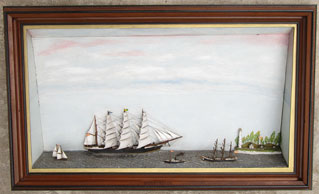
|
PERSPECTIVE 1 |
PERSPECTIVE 2 |
DETAIL 1 |
DETAIL 2 |
DETAIL 3 |
DETAIL 4 |
LIGHT HOUSE |
BACK |
2.03 FAMOUS BATTLESHIP MODEL with MUSEUM PROVENANCE. Exhibition-quality model of the World War II dreadnought USS CALIFORNIA (BB-44). This sailor-built model is faithful to the original ship and was actually built on board during one of the most famous Naval battles in history, the Battle of the Surigao Straits on October 25, 1944! The large wooden stand bears the engraved Bakelite plaque reading: "MODEL OF THE USS CALIFORNIA Hull turrets and guns are of balsa wood, superstructures are of white pine, gun shields and platforms are of bristol board. Model took 10 months to complete. This model has been through the battle of Surigao Straights in the Philippines. It was there when Mac Arthur landed on Leyte Island in the Philippines. Built by B. M. Mickschl CH CARP. USN." The hull measures 38 inches long by 7 inches wide and the model stands 10 1/2 inches high overall. The stout wooden base measures 41 inches long by 8 3/4 inches wide. Now complete with a professionaly-made custom Plexiglass case. This model is in an incredible state of original preservation considering its construction, detail and age. A genuine piece of history! 2495 ![]()
A well-known Museum has commissioned us to sell this model, because it is not in keeping with the Museum's collection objectives. For purposes of public anonymity we will not publish the Museum's name here. However we will provide provenance to the successful buyer so that this valuable aspect of the model's history will not be lost.
The USS CALIFORNIA (BB- 44) was a Tennessee-class battleship launched on November 20, 1919 by Mare Island Navy Yard, California and was commissioned on August 10, 1921, as flagship of Pacific Fleet -- a duty she retained until 1941. She took part in the Presidential reviews of 1927, 1930, and 1934 and was modernized in 1929-1930.
On "The Day of Infamy," December 7, 1941, she was moored at the southernmost berth of "Battleship Row" in Pearl Harbor, Hawaii. At 0805 a bomb exploded below decks in an ammunition magazine killing 50 men and setting her afire. A second bomb ruptured her bow plates. Despite valiant efforts to keep her afloat, CALIFORNIA settled into the mud with only her superstructure above the surface. When the action ended, 98 of her crew were lost and 61 wounded. On March 26, 1942 she was refloated and departed under her own power for Puget Sound Navy Yard for major reconstruction.
Restored to her original glory, CALIFORNIA sailed from Bremerton on January 31, 1944 in time to provide shore bombardment for the invasion of the Marianas Islands. During the bitter fight for Saipan in June, she was conducting shore bombardment when struck by an enemy shore battery killing one man and injuring nine. Following Saipan, her heavy guns helped blast the way during the assaults on Guam and Tinian.
In September 1944 CALIFORNIA prepared for the invasion of the Philippines. From October 17 through November 20 she played a key role in the Leyte operation, including participation in the last classic Naval battle ever fought between surface combatants, the Battle of Surigao Strait on October 20th. That momentous engagement resulted in the decimation of the Japanese fleet. On January 6, 1945 while providing shore bombardment at Lingayen Gulf she was hit by Kamikazes, killing 44 and wounding 155. Again she departed the front to undergo repairs Stateside.
Returning to action at Okinawa in June 1945, CALIFORNIA remained until July 21st. Two days later she joined Task Force 95 to cover minesweeping operations in the China Sea. After the surrender of Japan in early August, CALIFORNIA sailed via Singapore, Colombo, and Capetown, to Philadelphia, with a fitting arrival on December 7th. She was placed in reserve on August 7, 1946 and ultimately sold for scrap in 1959.
CALIFORNIA received seven battle stars for World War II service. Today, her bell rests in a memorial at Capital Park, Sacramento, a fitting tribute to a fine ship and her crew.
Length overall: 624' 6"
Beam: 114'(1943)
Mean Draft: 30' 5"
Displacement: 40,950 tons (1943)
Speed: 20 knots (1943)
Main guns: 12 14"/50 cal. (Mk 11), 4 triple turrets
Secondary: 10 x 5"/51 cal. mounted in sponsons
16 x 5"/38 cal. in 8 twin turrets (1945)
56 x 40mm Bofors in fourteen quad mounts
6 x 50 cal. heavy machine guns
80 x 20mm Oerlikons
2 x 21" Torpedoes
Complement: 57 officers, 1026 men

|
||||
2.67 DETAILED STEAM/SAIL SHIP MODEL. Really superb scratch-built and dated American model of a steam/sail brig from the 19th century. This period model is entirely hand made with precision detail and near scale rigging. The laminated wooden hull is beautifully sculpted and has a hollow interior with keel, tween deck, and lead ballast. The wooden deck in old mustard paint is scored to simulate planking. Details include bowsprit with dolphin striker and chain stays; billet head; both kedge anchors; rotating foc'sle capstan; fife rails; main deck hatch with accommodation ladder; removable deck house with funnel; steam whistle; "Charlie Noble"; 2 ventilators; 2 lifeboats; ship's bell; deck ladder; doors; windows with glass; aft house with door and glazed windows; functional helm; poop deck ladders; helm bell; poop deck skylight and realistic brass eagle sternboard! But there is much more! The deck house is signed on the bottom "Built 1876 to 1882." Using extreme care it may be safely removed to reveal an internal gearing system attached by a leather belt to an arbor running through the port side bulwark. Engaging the arbor with a clock winding key actually rotates the vessel's propeller! When the deck house is in place, the funnel is secured by 4 removable guy wires. As mentioned, the helm is functional and works as a real ship's steering station of the period. The helm is fitted with a wooden spindle attached to the steering gear. Turning the wheel to the left or right actuates the rudder in the appropriate direction! If the realism of this presentation were not enough, the entire model is mounted to a beautifully constructed dockyard cradle complete with hull supports making for a realistic stand. This exceptional model measures 40 1/2 inches long overall by 13 1/2 inches wide at the mains'l yard and 29 inches tall. Condition is nothing short of perfect. All surfaces retain their original old paint. The fine, realistic rigging is original and is in a sound, outstanding state of preservation. A nicer folk art model of its type is not to be found! 3800 ![]()
|
||||||||
|
2.19 DOCKYARD MODEL. Authentic mid-19th C. cased shipyard builder's half hull model of the 3-masted sailing ship VERBENA built by "Wm Pickersgill & Sons, Sunderland," England as identified in hand-painted lettering below the bow. This exceptional model exhibits all of the detail and quality expected of an "owner's model" as built by the shipyard that produced the actual ship. Fine, fancy original glazed hardwood case measuring 85 inches long, 17 1/2 inches high and 9 inches deep overall. The model itself measures 70 1/2 inches long from stern to bowsprit. Circa 1856. Immaculate condition throughout. Certainly worthy of the finest museum!
"Lloyd's Register of Shipping" Volume 1871 lists the VERBENA as a wooden hull bark of 260 feet in length, displacing 466 tons net. She was built in Sunderland in 1856 and operated by J. Whitfield of Sunderland.
In a publication entitled "Sunderland Builds Ships," 1989, Tyne and Wear Archive Service, City of Sunderland, England, William Pickersgill is identified as one of the prominent Wearside (River Wear) shipbuilding firms from 1847-1936.


